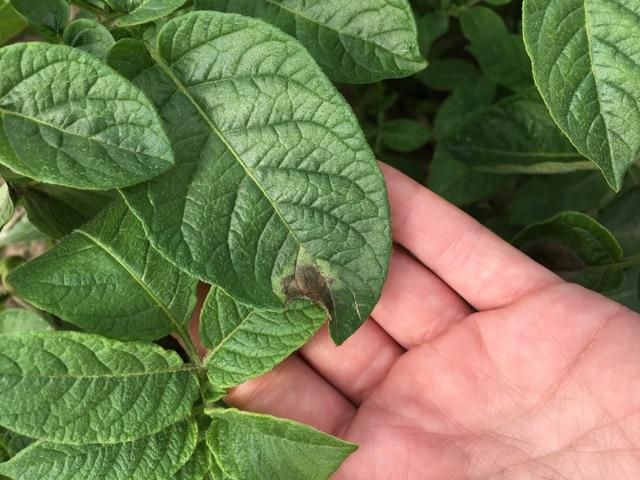Late blight was found yesterday (July 19) in the Delhi area, in a field with two spore traps. There were only a few plants with dried up lesions.
According to the grower, he had sprayed Curzate + Bravo + Copper as a preventative treatment.
This week, spore traps caught late blight spores in the Shelburne, Alliston and Simcoe Delhi areas.
It has been a very wet year so far, and it is no surprise that late blight has been found in a few fields. Wet conditions – rain, dew and foggy periods – have been common and created perfect conditions for disease development. Also wet weather promotes rapid crop growth.
Late blight can develop in fields with a good spray program because perfect spray coverage is difficult to achieve or new growth is so rapid that it is unprotected two days after the last spray.
At the 2015 Potato Conference, Dr. Gary Secor said: “The more comprehensive the coverage, the better the control. No areas should be left untreated. Water volumes should be 20 to 25 gallons per acre. There is little advantage to higher volumes.”
Here is the list of registered specific late blight fungicides. Rotate and tank mix them with broad spectrum fungicides such as Bravo Zn or EBDC’s (Manzate, Dithane, etc.) to delay the development of resistance:
- Curzate: An excellent product with 36 hour kick back effect. Do not apply it when temperature exceeds 28 C.
- Gavel: Recommended by Gary Secor: Applications toward the end of season to protect tubers.
- Kocide, Parasol: Copper hydroxide killed late blight spores in a study conducted by Gary Secor.
- Orondis Ultra: An excellent product, but expensive.
- Presidio: Very good according to Neil Gudmestad.
- Ranman, Torrent: Very good reports from Michigan and Manitoba.
- Revus: Very good, use anytime during the season.
- Tattoo C: Very good, but it will not be available as of 2018.
- Allegro: Used in Europe.
- Forum and Zampro: BASF fungicides that contain Acrobat.
- Confine, Rampart, Phostrol: They are phosphonates that are truly systemic.
The U.S. Blight Map, https://usablight.org/map, shows that the US 23 late blight strain found attacking tomatoes in southwestern Ontario is susceptible to Ridomil (metalaxil).
There is a high probability that the strain found in potatoes in the province is US 23 and also susceptible to Ridomil.











